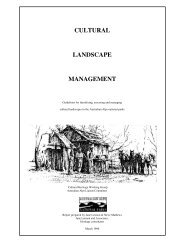Mining Heritage of the Australian Alps - Australian Alps National Parks
Mining Heritage of the Australian Alps - Australian Alps National Parks
Mining Heritage of the Australian Alps - Australian Alps National Parks
Create successful ePaper yourself
Turn your PDF publications into a flip-book with our unique Google optimized e-Paper software.
INTRODUCTION<br />
This report is a strategic assessment <strong>of</strong> mining heritage in <strong>the</strong> <strong>Australian</strong> <strong>Alps</strong> that<br />
begins with a <strong>the</strong>matic study. It has been a monumental task that can be considered<br />
begun, not completed, because mining has been such a complex and pervasive influence<br />
throughout <strong>the</strong> <strong>Australian</strong> <strong>Alps</strong> <strong>National</strong> <strong>Parks</strong> and attached Historic Areas.<br />
The difficulty, <strong>of</strong> course, is in <strong>the</strong> definition <strong>of</strong> mining heritage. O<strong>the</strong>r <strong>the</strong>matic studies, for<br />
example on huts <strong>of</strong> <strong>the</strong> <strong>Alps</strong>, have dealt with discrete objects. That is, <strong>the</strong>re are only so many<br />
surviving huts, and <strong>the</strong> <strong>the</strong>med studies have had a beginning and an end. Thematic studies <strong>of</strong><br />
<strong>the</strong> Snowy Mountains scheme and <strong>the</strong> skifields would be geographically constrained, relating to<br />
developments in particular topographies and altitudes within <strong>the</strong> <strong>Alps</strong> <strong>National</strong> <strong>Parks</strong>. While<br />
<strong>the</strong>ir local impact has been enormous, <strong>the</strong>ir influence does not touch <strong>the</strong> greater portion <strong>of</strong> <strong>the</strong><br />
study area. Grazing and sawmilling have affected a larger area, but <strong>the</strong>y are service industries<br />
that, in historical times, were greatly influenced by local and regional demand, a demand driven<br />
by <strong>the</strong> massive changes being wrought by gold to <strong>the</strong> demographics <strong>of</strong> Australia. Both were<br />
constrained by environmental factors – suitable high-altitude grasslands or wide lowland valleys<br />
for <strong>the</strong> former, and suitable lumber species & growth characteristics for <strong>the</strong> latter. Cattle<br />
grazing, in particular, was not labour intensive, and while <strong>the</strong> environmental influence may prove<br />
to be long-lasting, <strong>the</strong> cultural heritage is largely tied up in <strong>the</strong> legends <strong>of</strong> <strong>the</strong> relatively-few<br />
cattlemen, ra<strong>the</strong>r than deeply imprinted in <strong>the</strong> landscape.<br />
<strong>Mining</strong>, on <strong>the</strong> o<strong>the</strong>r hand, is not constrained by topography, altitude or environment, nor is it<br />
influenced by regional or even national demand. There would not be a creek or river within <strong>the</strong><br />
entire study area that has not felt <strong>the</strong> blow <strong>of</strong> a prospector’s pick and <strong>the</strong> rattle <strong>of</strong> a gold pan<br />
some time in <strong>the</strong> last 150 years, nor a mountain range that has not echoed to <strong>the</strong> ho<strong>of</strong> beats <strong>of</strong> a<br />
prospector’s pack-horse. Nearly a billion dollars worth <strong>of</strong> metals, principally gold, has been<br />
wrought from <strong>the</strong> <strong>Australian</strong> <strong>Alps</strong>, but this is only <strong>the</strong> tip <strong>of</strong> <strong>the</strong> iceberg. Metals production itself<br />
is limited by <strong>the</strong> existence <strong>of</strong> actual resources, but perversely, mining activity is not. An<br />
important cultural dimension operated - <strong>the</strong> lure <strong>of</strong> gold & o<strong>the</strong>r precious metals, and <strong>the</strong><br />
promise <strong>of</strong> instant wealth, drove <strong>the</strong> level <strong>of</strong> activity in <strong>the</strong> early years.<br />
A complex mining infrastructure was overlain on <strong>the</strong> <strong>Alps</strong>. A network <strong>of</strong> tracks, from blazed<br />
foot-trails to formed roads, connected <strong>the</strong> mining areas and individual mines to each o<strong>the</strong>r,<br />
adjacent towns & regional centres, criss-crossing <strong>the</strong> <strong>Alps</strong>. <strong>Mining</strong> settlements, from ephemeral<br />
camps to substantial townships, rose and died in <strong>the</strong> <strong>Alps</strong>, <strong>the</strong>ir fortunes inevitably tied to <strong>the</strong><br />
supply <strong>of</strong> gold. Support industries such as grazing, cropping and sawmilling grew with arrival <strong>of</strong><br />
<strong>the</strong> diggers in what had been at best lightly-settled uplands and at worst untracked wilderness, in<br />
European cultural terms. As mining became more sophisticated, a new network <strong>of</strong> water races,<br />
dams, tramways, tracks & treatment sites was added. But as resources dwindled and prices<br />
languished, mining in <strong>the</strong> <strong>Alps</strong> slowly strangled. The bush is reclaiming <strong>the</strong> land, and time<br />
dimming a fascinating page in <strong>the</strong> golden history <strong>of</strong> Australia.<br />
The enormous individual contributions made to <strong>the</strong> mining heritage <strong>of</strong> <strong>the</strong> <strong>Alps</strong> sets it<br />
apart from o<strong>the</strong>r European cultural activities. The <strong>Alps</strong> mining heritage is not collective<br />
– it is tens <strong>of</strong> thousands <strong>of</strong> individual labours, each indelibly imprinted in <strong>the</strong> landscape<br />
because <strong>of</strong> <strong>the</strong> very nature <strong>of</strong> mining. For <strong>the</strong> vast majority <strong>of</strong> miners, <strong>the</strong>ir Alpine<br />
experiences were but brief episodes in <strong>the</strong>ir journeys <strong>of</strong> life. Yet in <strong>the</strong> <strong>Alps</strong> today, <strong>the</strong>ir<br />
efforts are still etched in <strong>the</strong> shallow shafts, tunnels and sluicing works, each holding its<br />
own unique story <strong>of</strong> hope, toil, frustration, desperation, disappointment or excitement,<br />
that in most cases will never be revealed…..<br />
iii

















